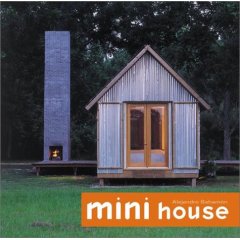Mini House
Published in Architecture New Zealand, July/August 2003.
Mini House presents 26 dwellings ranging in size from 344 to 1291 square feet located in Australia, Japan, the US and Europe. Of the these, only 7 are sited in an urban/suburban context with their footprint being determined by the tight site parameters. These show some inventive solutions for organising space within the constraints of the urban parcels.

The remaining houses are holiday houses or weekenders located in uncluttered natural environments – by the sea or in the mountain. These environments have afforded the architects with the opportunity that holiday houses provide – of paring back to the essentials of space.
Across the range of the houses there are essentially two typologies- a reduced form of gable house, and the box – (There are variations on the extent, directions and proportions of the facade). A number of examples have a familiar resonance to recent domestic architecture in New Zealand, but there is a fundemental difference between the way those on the other side of the equator address the relationship of the interior to the exterior environment. These dwellings are much more about shelter and of looking-out-from-within.
Timber framed construction, timber cladding, including plywood are employed in a number of the examples and often handled in a beautifully crafted, yet simple manner, that transforms the interiors into pieces of furniture. The same can be said for some of the exteriors.
The format for each project is the same throughout this graphically very pretty little book – 2-3 double pages with a description on the first double spread, with plans, sections and elevations and numerous, generally quite good photos, following.
Despite the graphical tightness of the book’s presentation, this publication is let down by the quality of the text in a number of descriptions, sloppy editing and one suspects, by a translator who is unfamiliar with architectural and construction vocabularly. The scale for plans and elevations varies to suit the graphic layout for a particular project. This is irritating when one is viewing the plans in relation to each other and the header for each project includes the area in square feet with most of the plans appearing to have a metric scale
Having said that however, it is the images and the drawings of each project are the most important component in this type of publication.
This book whets the appetite and one finds oneself peering closely at the photographs wondering how bits of the building were put together, looking for clues in the small and finely drawn plans and sections. This is ulimately the typical frustation of what is essentially a coffee table book.
Mini House
By Alejandro Bahamon
ISBN 0-06-051359-4
Harper Colins International
2003
Christina van Bohemen
